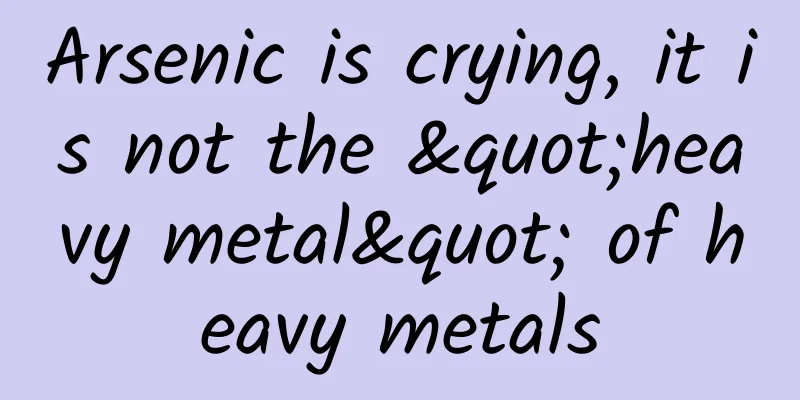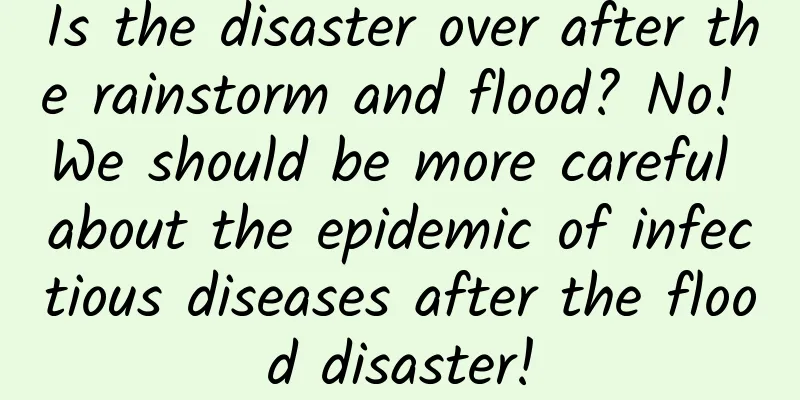Arsenic is crying, it is not the "heavy metal" of heavy metals

|
Often, when it comes to water pollution, environmental pollution, or even cosmetic pollution[1], as long as we mention heavy metals, people will think of mercury, lead, arsenic, cadmium, etc. So is arsenic a heavy metal? What is the definition of heavy metals? Why is arsenic mentioned in heavy metal pollution? 1. Definition of heavy metals In chemistry, we define heavy metals as metals with a density of more than 4.5 g/cm3. From atomic numbers ranging from 23 (vanadium) to 92 (uranium), excluding 9 non-metallic elements such as arsenic, selenium, bromine, krypton, tellurium, iodine, xenon, astatine, and radon, as well as the artificial element technetium, there are a total of 60 natural metal elements, as shown in Figure 1. Among these 60 elements, excluding rubidium, strontium, yttrium, cesium, barium, and francium, the remaining 54 metals have densities greater than 4.5 g/cm3 (see Table 1). Therefore, from the perspective of density, these 54 metals are all heavy metals. However, when classifying elements, some of them are classified as rare earth metals, and some are classified as precious metals, etc., as shown in Table 2. Among the remaining 13 metals, the four metals that are closely related to heavy pollution incidents are mainly lead, mercury, cadmium, and chromium. Figure 1 Arrangement of natural metal elements 23 to 92 in the periodic table (as shown in the box) Table 1 Density of 60 natural metal elements Table 2 Classification of 54 heavy metal elements 2. Hazards and toxicity of heavy metals Due to a lack of environmental awareness, people inadvertently release large amounts of heavy metals into the environment during industrial and agricultural production such as ore mining, metal smelting, machinery manufacturing, and agricultural irrigation[2], which in turn causes water or soil pollution, thus affecting human health and safety. Heavy metal pollution is characterized by being enrichable, difficult to degrade, highly toxic, and difficult to control. Most heavy metal pollution incidents are caused by oral ingestion[3]. Excessive intake of heavy metals will cause acute poisoning symptoms, mainly manifested as vomiting, abdominal pain, diarrhea, difficulty breathing, ulcers, etc. After being absorbed into the body, they can damage the physiological functions of various tissues and even cause death. In addition, heavy metals are more harmful to the development of the fetus, especially mercury, which has been confirmed in the "Minamata disease" incident in Japan[4]. The following is a brief introduction to the toxicity of several common heavy metals, see Table 3. Table 3 Toxicity of common heavy metals 3. Arsenic Arsenic, commonly known as arsenic, is located in the 4th period and VA group of the periodic table of chemical elements. It is a non-metallic element and is widely distributed in nature. Animals, plants, and seafood may contain trace amounts of arsenic. In nature, arsenic mainly exists in the form of sulfides such as realgar[5]. Arsenic compounds are also widely used, and are often used in herbicides, fungicides, wood preservation, pharmaceuticals, pigments and other industries. 3.1 Name evolution There are many arsenic compounds, which have been used as "heritage medicines" in various countries from ancient times to the present. However, the same mineral may have different names in different countries and at different times. Arsenic minerals are mostly realgar and orpiment. As early as the 4th century BC, Aristotle named it Arsenikon (originally referring to orpiment), which means "powerful". Realgar Orpiment is derived from Auripigmentum (golden pigment) of the Roman naturalist Plony. Realgar in English is closer to "cockscomb stone". For example, realgar wine is called "Realgar wine", which is often used when introducing Chinese festival customs. In China, the naming of arsenic minerals is more complicated. In order to maintain mystery [6], ancient alchemists and doctors gave it many names, as shown in Table 4 and Figure 2. Table 4 Other names for arsenic minerals in ancient China Figure 2 Appearance of arsenic and its compounds (picture from the Internet) Arsenic trioxide is the most classic name for arsenic trioxide As2O3. It is processed and refined from arsenic stone. It has higher purity and changed properties. Arsenic stone is often used to kill bacteria and is used to treat cold phlegm asthma, malaria, hemorrhoids or ringworms, while arsenic trioxide has the effect of corroding sores, removing decay and killing insects, and is also more toxic. 3.2 Toxicity of arsenic and its compounds When it comes to arsenic, the first thing that comes to mind is that it is toxic. This is all thanks to the most classic arsenic-containing poison - arsenic trioxide (As2O3), also known as arsenic trioxide. In fact, elemental arsenic is basically non-toxic, and most arsenic sulfides are not so toxic. According to the properties of the compounds, it can be divided into organic arsenic and inorganic arsenic. Inorganic arsenic is more toxic than organic arsenic. Among inorganic arsenic, trivalent arsenic and pentavalent arsenic are more common, with trivalent arsenic being more toxic, about 60 times that of pentavalent arsenic. After entering the human body, arsenic will accumulate in the bones, liver, kidneys, spleen and other parts of the body, causing harm to the nervous, cardiovascular, respiratory, reproductive, blood and other systems. Moderate arsenic poisoning mainly affects sensory nerves in the early stages, such as pain and slow reaction; severe arsenic poisoning will affect motor nerves, such as weakness in the limbs, paralysis or brain tissue lesions. Chronic arsenic poisoning can cause neuropathy, mainly manifested as neurasthenia syndrome, skin damage, oral inflammation or liver and kidney damage. The recovery time is particularly long, taking up to several years, and the chance of complete recovery is very small; the most common symptoms of arsenic exposure are thickening of the stratum corneum and darkening of the skin color. In severe cases, skin cancer may occur; arsenic can also affect the development of the fetus through the placenta; acute or chronic arsenic exposure will affect the blood system, causing a decrease in white blood cells, red blood cells and platelets, and an increase in the number of eosinophils [7]. 4. Relationship between arsenic and heavy metals Arsenic is located on the boundary between metal elements and non-metal elements in the periodic table, so it is called a metalloid, also called a semi-metal. Its physical and chemical properties are also between metals and non-metals. It has a silver-grey metallic luster and a density of 5.72 g/cm3. It also has the characteristics of bioaccumulation and non-degradability in the environment. Its toxicity and treatment methods are similar to those of heavy metals, so arsenic is considered a heavy metal in the field of environmental pollution and medicine[8]. Therefore, in my country's "List of Priority Controlled Chemicals (First Batch)"[9], "List of Toxic and Hazardous Water Pollutants (First Batch)"[10] and "List of Toxic and Hazardous Air Pollutants (2018)"[11], arsenic is managed as a key controlled pollutant together with four other heavy metals: lead, mercury, cadmium and chromium. 5. Conclusion The so-called "five poisons" of heavy metal pollution that we usually see include mercury, cadmium, lead, chromium, and arsenic. Although arsenic is included, it is not a heavy metal. It is a non-metal. Because it is located on the boundary between metal and non-metal, it is also called a metalloid. It is highly similar to heavy metals in environmental pollution and toxicity, so it is regarded as a heavy metal in the field of environment and medicine. References [1] Zhang Han, Song Hongjie, Lü Yi. “Heavy metal pollution case” in the cosmetics world. University Chemistry, 2022, 37(9): 264 |
<<: What a wonderful bird with a singing voice that calls the morning light and red ears that chirp!
Recommend
If you are angry, just vent it out? It turns out that we have been doing it wrong all along.
It is inevitable to feel angry and furious in dai...
A 20-year-old college student was blown into the ICU by the air conditioner! The recent high incidence! Doctors urgently remind...
It is said that "Summer's life is given ...
Why is it easy for "polyps" to grow in the intestines? What should I do if I find these "lumps" during a physical examination?
"Nodules", "polyps", "cy...
Polaris-Ahui short video operation practice class, 0-1 system teaching, 7-15 days independent operation account
Polaris-Ahui short video operation practice class...
It only takes 5 minutes to teach you how to play Super Fan Pass
On September 21, Weibo launched a new information...
iPhone sales are booming. How much of a role do Apple retail stores play?
Not long ago, Apple released its latest quarterly...
Tencent's love-style product operation method
What does it feel like to be in love? Most of the...
Which is the "oldest story of mankind"? The answer may be related to the Seven Fairies!
There are thousands of stories in this world, whi...
Windows 11 now supports Android. Can the Surface tablet change the iPad's monopoly?
Last week, a big event happened in the technology...
WeChat mini program function of milk tea shop, how to set up WeChat mini program of milk tea shop?
After the Qingming Festival, the temperature bega...
Robin Li talks about the difference between Baidu and Google: User-generated content
[[128274]] 1. Differences between Baidu and Googl...
The charm of Haobo GT's intelligent driving performance cannot be resisted. Machine learning expert Dr. Yu Kai came to the factory to pick up the car
When talking about luxury brands in the yoga worl...
Everyone has seen giraffes, but have you heard of the "long-necked dinosaur"?
Although the Mesozoic Era is called the "Age...
Useful Information | Learn Pinduoduo’s 5 high-conversion marketing strategies!
Pinduoduo, a new internet celebrity and a three-y...









